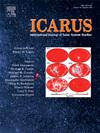Reassessing the origin and evolution of Ecliptic Comets in the Planet-9 Scenario
IF 2.5
2区 物理与天体物理
Q2 ASTRONOMY & ASTROPHYSICS
引用次数: 0
Abstract
A group of newly observed extreme trans-Neptunian objects show an unexpected level of orbital confinement, characterized by an approximate alignment of the orbital angular momentum vectors and apsidal lines. It has been proposed that a yet undiscovered giant planet (named Planet-9,) exists in the outer parts of the solar system and is causing this clustering. Initial studies suggested that Planet-9 could be as massive as 15. In this mass range, however, this planet tends to strongly interact with scattered disk objects (SDOS; au) and influence the dynamics and the orbits of a population of short period comets known as ecliptic comets. The outcome of this interaction is a population of ecliptic comets with orbital inclinations broadly inconsistent with observations. In this work, we model the formation and long-term dynamical evolution of trans-Neptunian object populations and Oort cloud during the solar system dynamical instability phase considering a revised set of mass and orbital parameters for Planet-9. In our simulation, Planet-9, is assumed to have a mass of , a moderately inclined orbit with deg, semi-major axis au, and orbital eccentricity of . Our results show that a relatively less massive Planet-9 is broadly consistent with the inclination distribution of trans-Neptunian objects and the observed number of ecliptic comets ( km) in the solar system. Furthermore, our results indicate that under the influence of Planet-9, distant Kuiper belt objects with and that are significantly inclined, are more likely to be apsidally aligned with the planet rather than anti-aligned, with an anti-aligned-to-aligned population ratio of approximately 0.5-0.7. Objects within this semi-major axis and perihelion range and with orbital inclinations lower than 20 deg (comparable to that assumed for Planet-9), however, exhibit significant apsidal anti-alignment. Within this low-inclination subset, the ratio of anti-aligned to aligned populations is approximately 2-4. These findings provide a novel observational direction that could help refine the search for this putative planet.
求助全文
约1分钟内获得全文
求助全文
来源期刊

Icarus
地学天文-天文与天体物理
CiteScore
6.30
自引率
18.80%
发文量
356
审稿时长
2-4 weeks
期刊介绍:
Icarus is devoted to the publication of original contributions in the field of Solar System studies. Manuscripts reporting the results of new research - observational, experimental, or theoretical - concerning the astronomy, geology, meteorology, physics, chemistry, biology, and other scientific aspects of our Solar System or extrasolar systems are welcome. The journal generally does not publish papers devoted exclusively to the Sun, the Earth, celestial mechanics, meteoritics, or astrophysics. Icarus does not publish papers that provide "improved" versions of Bode''s law, or other numerical relations, without a sound physical basis. Icarus does not publish meeting announcements or general notices. Reviews, historical papers, and manuscripts describing spacecraft instrumentation may be considered, but only with prior approval of the editor. An entire issue of the journal is occasionally devoted to a single subject, usually arising from a conference on the same topic. The language of publication is English. American or British usage is accepted, but not a mixture of these.
 求助内容:
求助内容: 应助结果提醒方式:
应助结果提醒方式:


